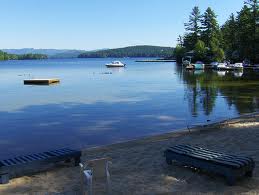Maine Lakefront Owners Need to Know About Buffer Zone Management

Lake Winnecook, (Unity Pond) Unity, Maine: Sail Away to Your Vacation Destination
April 19, 2012
Out and About for the Mid Coast Regions of Maine Apr. 26-May 2
April 24, 2012Maine Lakefront Owners Need to Know About Buffer Zone Management

Crystal Clear Kezar Lake in Lovell, Maine
Maine lakefront property owners should be aware of the need for vegetated buffer zones on their land. We all love Maine’s clear, pristine lakes, like Kezar Lake in Lovell, and above average results for water quality testing. Land use, however, impacts water quality in a negative way. The best way to achieve above average water quality is through best management practices, which help control erosion and storm water runoff.
Storm water runoff is the main way in which phosphorus enters the lake. Phosphorus makes algae grow, reducing the clarity of the water, causing an unpleasant appearance and depleting the oxygen supply sufficient to maintaining a healthy fishery. Directing runoff into a vegetated area to slowly percolate into the lake allows natural factors to remove the phosphate.
Healthy buffers are our last defense in the effort to preserve water quality. These riparian buffers are vegetated zones of land rather than green golf-course like lawns adjacent to the water. The buffer acts as a filter by absorbing water that is often laden with pollutants, sediments and nutrients that are harmful to the lake. Vegetation also helps control erosion.
Lakes in Maine encompassing greater than ten acres are known as Great Ponds. The State of Maine Shoreland Zoning Ordinance states the following:
• The shoreland zoning law prohibits any vegetation removal within the 75-foot buffer area around a great pond that is zoned for resource protection, except to remove safety hazards.
• In all other shoreland areas, no more than 40% of the total volume of trees over 4 inches in diameter in the buffer area may be harvested in any 10 year period.
• Furthermore, vegetation less than 3 feet in height, including ground-cover, cannot be removed from shoreland buffers.
• Pruning the lower third of the branches of a tree within the buffer is allowed.
Within 100 feet of great ponds and rivers flowing into great ponds, and within 75 feet of all other water bodies and streams:
• no opening in the forest canopy may exceed 250 square feet;
• a winding footpath not more than 6 feet wide is allowed,
• selective cutting is allowed, provided a well-distributed stand of trees remains.
The standards of the Shoreland Zoning Ordinance establish a rating system, which defines a “well-distributed stand of trees.” Within the buffer area, the waterfront property owner must maintain a minimum number of “points” worth of trees within any 25-foot by 50-foot area, and at least 5 saplings. Tree diameter is measured at 4 1/2 feet above the ground for a typical buffer in a residential zone. Points are assigned to trees, depending on their size: Under 2” = 0 points; 2” to < 4” = 1 points; 4” to < 8” = 2 points; 8” to < 12” = 4 points; and 12” or greater = 8 points. Twenty-four points worth must be maintained adjacent to great ponds and rivers flowing to great ponds, and 16 points worth must be maintained elsewhere.
Every 25’ x 50’ area within the 100’ buffer must contain at least 24 points plus 5 saplings and all vegetation under 3’ high. Whenever possible, no more than half of the points counted toward the 24-point threshold within any 25-foot by 50-foot rectangular area may consist of trees greater than 12 inches in diameter.
Beyond the 75-foot or 100-foot buffers mentioned above, clearing is also limited to no more than 40% of the volume of trees over 4 inches in diameter within a 10 year period. This means that the more land that is cleared for buildings, lawn, and driveways, the less can be thinned elsewhere. Further, cleared openings cannot exceed 25% of the lot area within the shoreland zone, or 10,000 square feet, whichever is greater. (info taken from the Maine Shoreland Zoning Guide: A Handbook for Shoreland Owners published by the Maine Department of Environmental Protection, Spring 2008)
Each town may be more restrictive, so call your local code enforcement officer for more information.
Natural beauty and clean, clear waters are a commodity in Maine. When you purchase lakefront real estate, you should have a consultant well versed and familiar with the Maine DEP and town regulations assist you in determining what you can and cannot remove from your lot. Think of the long-term viability of your plan. Think about protecting and improving the water quality of your lake and its watershed for the benefit of all.
To view lakefront property listings for sale on pristine Kezar Lake, Lovell in the Sebago Lakes Region of Maine, just click on the green box above.
For more information about Kezar Lake and Lovell, check out the links below:
Natural Beauty, Exceptional Vistas, and Lakefront Property Retreats Can All Be Found in Lovell, Maine
Overlooking Lower Bay of Kezar Lake, Ladies Delight Hill in Lovell is a Hike with History
